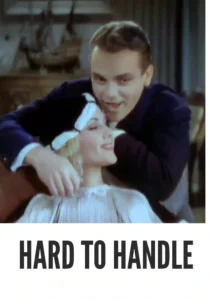Contact: info@alwanfilm.com
Video Sources 0 Views
- Watch trailer
- Hard to Handle 1933 Colorized

Synopsis
Table of Contents
ToggleHard to Handle 1933 Colorized Review: A Classic Comedy with a Colorized Twist

Introduction
When it comes to early comedies of the Great Depression era, few capture the energy and wit of the time like Hard to Handle (1933). Directed by Mervyn LeRoy and starring the ever-charismatic James Cagney, this film provides a comedic yet sharp commentary on the lengths people go to for success during challenging times. Originally released in black and white, Hard to Handle recently re-emerged in a colorized version that adds a fresh dimension to its classic scenes. In this article, we explore the impact of Hard to Handle (1933) through the lens of colorization, diving into its storyline, characters, and enduring relevance as a reflection of society’s ambitions.
Check The Full Colorized Movies List
Check Our Colorized Movies Trailer Channel
Understanding Hard to Handle 1933 Colorized: Director, Cast, and Genre
Director’s Vision
The genius behind Hard to Handle is director Mervyn LeRoy, who masterfully combines humor and social critique. Known for his work on films like I Am a Fugitive from a Chain Gang (1932), LeRoy brings a keen awareness of society’s struggles and aspirations, especially during the economic strain of the 1930s. With Hard to Handle, LeRoy pivots to comedy, but he uses it to explore serious themes about ambition, identity, and resilience. His direction allows the film to maintain a lively pace, while also letting moments of satire and critique shine through.
The Iconic Performance of Actors
Leading the cast is James Cagney as Lefty Merrill, a fast-talking promoter whose schemes are only outmatched by his relentless charm. Cagney’s performance captures the essence of a quick-thinking hustler, bringing energy and humor to each scene. His impeccable timing and physical comedy create a character that is both captivating and flawed—a man who tries to rise above his circumstances but often finds himself on the wrong side of luck.
Ruth Donnelly plays the role of Ruth Waters, Lefty’s partner-in-crime and love interest. Her portrayal adds a level of sophistication and cunning that serves as a foil to Cagney’s character. Donnelly’s performance contributes to the film’s comedic dynamic, as her character is both an accomplice and a competitor in Lefty’s schemes. Supporting actors like Mary Brian and Robert McWade round out the cast, adding depth and humor to the ensemble.
Exploring the Genre
Hard to Handle (1933) is a classic screwball comedy, a genre known for its fast-paced dialogue, absurd situations, and witty banter. Screwball comedies were popular in the 1930s and 1940s, providing audiences with an escape from the hardships of the Great Depression. The genre often included strong female characters and unconventional romances, both of which are present in Hard to Handle. The film’s blend of comedy and social critique makes it a standout example of the screwball genre and a timeless representation of American cinema.
Exploring the World of Hard to Handle 1933 Colorized: Plot and Characters
Detailed Synopsis
The plot of Hard to Handle (1933) follows Lefty Merrill (James Cagney), a sharp-witted promoter always on the lookout for the next big scheme. The film opens with Lefty orchestrating a dance marathon, a popular attraction during the Depression era, but as the event ends in financial disaster, Lefty finds himself broke and looking for a new venture. His search for success is complicated by a series of schemes, including selling miracle health products and promoting beauty contests.
As Lefty navigates these get-rich-quick plans, he encounters Ruth Waters (Ruth Donnelly), a woman with similar ambitions and an eye on Lefty’s potential. Their relationship is fraught with conflict and humor, as both characters try to outsmart each other in the pursuit of success. With witty exchanges and slapstick humor, Hard to Handle portrays the highs and lows of Depression-era ambition through the lens of Lefty’s relentless schemes.
The film’s supporting characters add layers of intrigue and comedy, with each scheme bringing a new cast of quirky individuals into Lefty’s life. From his business partners to his romantic interests, these characters bring the story to life, adding depth and humor to the film’s portrayal of ambition and resilience.
The Art of Film Colorization
Understanding the Process
Film colorization is a transformative process, allowing black-and-white films to be viewed with added color. Initially developed through techniques like hand-painting and chemical tinting, colorization has evolved significantly with the advent of digital technology. The process now involves digitally enhancing each frame, selecting color palettes that reflect the era and mood of the film.
The colorization of Hard to Handle (1933) required meticulous attention to detail, ensuring that the colors chosen for costumes, props, and settings align with the film’s original aesthetic. The result is a viewing experience that feels both nostalgic and modern, providing contemporary audiences with a new way to appreciate classic films.
Development Over Time
Colorization has seen a shift in perception over time, moving from a novelty to a respected technique. Early colorization methods were sometimes criticized for appearing artificial or inaccurate, but advancements in technology have allowed for more sophisticated and nuanced applications. Modern digital colorization has created an opportunity to reintroduce classic films to younger audiences, preserving the film’s authenticity while adding a new layer of visual appeal.
Early Colored Films: A Brief History
Emergence of Early Colored Techniques
The early 20th century saw several attempts to bring color to cinema, with techniques like tinting and toning paving the way. These methods involved adding color to entire frames or specific sections, creating a limited but impactful color effect. By the 1930s, Technicolor had revolutionized color film, using three strips of film to capture the full color spectrum. Technicolor allowed filmmakers to present vibrant, lifelike colors, setting a new standard for cinema.
While Hard to Handle (1933) was initially released in black and white, the colorized version offers a glimpse into what the film might have looked like had it been shot with access to Technicolor technology. This reimagining allows audiences to experience the story with a new layer of vibrancy.
Hard to Handle 1933 and Its Early Colored Version
The Decision to Release in Color
The decision to colorize Hard to Handle (1933) was driven by a desire to reintroduce the film to modern audiences. The colorized version offers a fresh perspective on the film’s visual elements, highlighting details that were previously hidden in black and white. For instance, the colorization allows viewers to better appreciate the costumes, set designs, and locations that contribute to the film’s atmosphere.
Impact on the Visual Narrative
Colorization has a significant impact on Hard to Handle’s visual narrative, enhancing its appeal and bringing out new details in each scene. The colorized version highlights the contrast between the vibrant schemes Lefty pursues and the more subdued reality of Depression-era America. The added color brings a new dimension to the film, making it feel more accessible to contemporary audiences while retaining its original charm.
The Debate Over Film Colorization
Controversy Surrounding Colorization
Film colorization has sparked debate among critics and filmmakers. Some argue that adding color to black-and-white films can compromise the director’s artistic intent and dilute the film’s historical authenticity. Others believe that colorization allows classic films to reach wider audiences, offering a new way to experience and appreciate older films.
The colorization of Hard to Handle (1933) exemplifies this debate. While some viewers may prefer the original black-and-white version for its period-accurate aesthetic, others may enjoy the enhanced visual appeal of the colorized version.
Examining Hard to Handle 1933 as an Early Colored Film
Enhancement or Distraction?
The colorization of Hard to Handle (1933) adds a layer of depth to the film’s visuals, allowing viewers to engage with the story in a new way. The vibrant colors draw attention to the period-specific costumes and set designs, enhancing the film’s nostalgic appeal. However, some purists argue that the colorization may distract from the film’s original aesthetic, potentially altering its impact.
Ultimately, the effectiveness of the colorized version depends on individual preferences. While some viewers may appreciate the added visual dimension, others may prefer the authenticity of the original black-and-white format.
Influence and Legacy: Hard to Handle 1933 Colorized’s Impact on Cinema
Influence on Screwball Comedy
Hard to Handle (1933) has had a lasting impact on the screwball comedy genre, inspiring subsequent films and setting a standard for quick-witted, energetic comedies. Its success demonstrated the appeal of fast-paced dialogue and absurd situations, encouraging filmmakers to explore similar themes. The film’s influence can be seen in later screwball comedies, which continue to draw on its blend of humor and social critique.
Director’s Cinematic Legacy: Beyond Hard to Handle 1933 Colorized
Mervyn LeRoy’s Influence
Mervyn LeRoy’s career extended far beyond Hard to Handle (1933), with a filmography that includes classics like Little Caesar (1931) and Quo Vadis (1951). LeRoy’s ability to navigate different genres and his dedication to storytelling have solidified his legacy as a versatile and influential director. His work on Hard to Handle exemplifies his skill in blending humor with social commentary, a hallmark of his style.
Themes Explored in Hard to Handle 1933 Colorized
Ambition, Deception, and Resilience
Hard to Handle (1933) explores themes of ambition, deception, and resilience, reflecting the societal struggles of the Great Depression. The film delves into Lefty’s relentless pursuit of success, often at the expense of his integrity. Through humor and satire, the film addresses the darker side of ambition, highlighting the challenges and sacrifices that come with striving for success.
Reception and Controversy Surrounding Hard to Handle 1933 Colorized
Initial Reviews and Audience Reactions
Upon its release, Hard to Handle (1933) received positive reviews, with critics praising Cagney’s performance and the film’s comedic energy. The colorized version, however, has sparked mixed reactions, with some viewers appreciating the added visual appeal while others question the need for colorization.
Where to Watch Hard to Handle 1933 Colorized Online
Hard to Handle (1933) is available on various streaming platforms, including Amazon Prime Video and TCM. Both the original black-and-white and colorized versions are accessible, allowing viewers to choose their preferred viewing experience.
FAQs About Hard to Handle 1933 Colorized
Q: Who stars in Hard to Handle (1933)? A: James Cagney leads the cast as Lefty Merrill, with Ruth Donnelly and Mary Brian in supporting roles.
Q: What genre is Hard to Handle (1933)? A: The film is a screwball comedy, blending humor with social commentary.
Q: Is the colorized version worth watching? A: The colorized version offers a fresh visual experience, though some viewers may prefer the original black-and-white format for its historical authenticity.
Conclusion
Hard to Handle (1933) remains a significant film, both for its comedic brilliance and its exploration of ambition during challenging times. The colorized version provides a new way to experience the film, adding vibrancy while sparking debate about film colorization. Whether viewed in its original form or with the added dimension of color, Hard to Handle continues to captivate audiences and stands as a testament to the enduring appeal of classic cinema.












